If your next embarkation is on a Bulk carrier ship or you are on this site because you are curious about the Maritime world, I can assure you that you are in the right place.
I wanted to create this guide on Bulk carrier ships to clarify the dynamics involving this type of ship.
The Bulk Carrier ship is a type of ship that carries Bulk cargo, such as grain cereals, rice, and many other types.
The definition of bulker name is also specified by the IMO, defining it as a ship capable of carrying dry cargo in Bulk.
1950 Firsts Bulk Carrier Ships
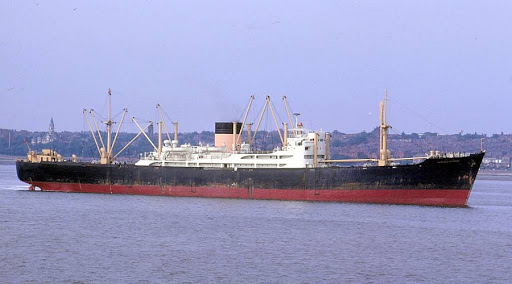
First Bulk Carrier ship
The development of this type of ship dates back to 1950, where these ships were built to meet the needs of transporting grain, cereals, Coal, and other materials carried in Bulk
Nowadays, bulk carrier ships represent a substantial portion in the Maritime world. It is thought to be 33%.
This type of ship is equipped with cranes and can unload and load bulk goods in the ports of arrival and departure, always considering the limits of the latter.
In general, these cranes are installed on ships with a MAXIMUM DWT of 40000 tons.
Bulk Carrier ship general characteristics
- they have a capacity ranging from three thousand to 300,000 tons of Bulk cargo
- they have an average speed ranging from 12 to 15 knots
- single bridge
- ships that do not exceed 40000 tons of transport are also equipped with cranes
- usually, at least one of the holds is used for ballast
- are equipped with hydraulic means to allow the opening and closing of the hatches.
Cargo Holds hatch
Cargo Hold Of A bulk carrier

Cargo Hold Spaces on Bulk carrier ships
Bulk carrier ships are equipped with unobstructed opening means to facilitate the loading and unloading process.
Some types of Bulk carrier ships carry out the unloading of goods in the hold through special means such as Bulldozer, and for this reason, the lower part of the hold must be reinforced more.
System Installed in The Holds
- the pump part of the hold
- an alarm signaling when the water level exceeds 0.5m
- second water level alarm and 15% of the holding capacity.

Hatch Cover
Bulk Ships’ Hatches are made of steel and typically extend 40-60% of the ship’s width and 56-67% of the length of each Cargo Hold.
There are different types of hatches in Bulk carrier ships, installed with criteria and taking into account the size of the ship itself.
Ballast Tanks in Bulk Carrier Ships
Bulk Carrier ships must have a sufficient number of ballast tanks to allow a correct immersion to the propeller, correct stability, and trim
Cargo Gear On Bulk carrier ship
Crane On bulk carrier ships
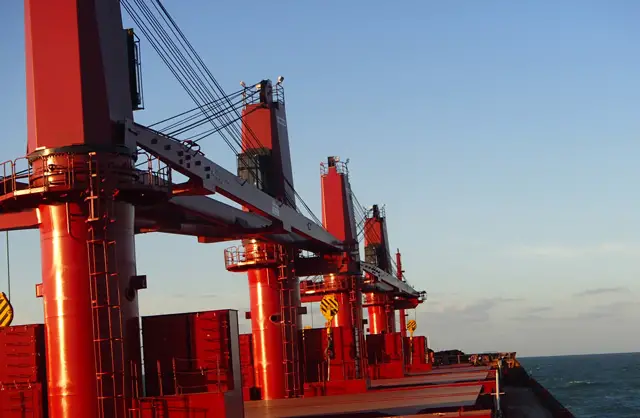
Handymax size Cranes
The Handymax Size usually have 4 Cranes
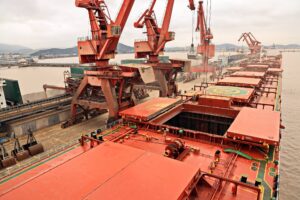
Large Bulk Carrier ship with no Crane
No Cranes
As previously mentioned, some types of Bulk carrier ships are equipped with cranes, such as the handymax size, which usually have 4 cranes.
The position of these cranes depends on the type of ship length.
However, the larger Bulk carrier ships do not carry any cranes and must rely solely on land-based vehicles in the various unloading and loading ports.
Certainly, it can be seen as an advantage for the owner since it does not require maintenance and replacements in case of damage to the cranes.
Speed of service and fuel consumption in Bulk carrier vessels
The average speed of a bulk carrier ship in 14/15 knots can be considered a not very high speed, but the type of ship is the purpose for which it was built guarantees efficient economic returns to the owner.
Types of Bulk carrier vessels
In the following table, you will find the dimensions and the different sizes of the most common Bulk carrier vessels.
| TYPE | Lengh Overall (m) |
|---|---|
| Mini Bulk Carrier | 100-130 |
| Handysize | 130-150 |
| HandyMax | 150-200 |
| Panamax | 200-230 |
| Capesize | 230-270 |
| Suezmax | NA |
| Very Large Bulk Carrier ( VLBC) | 270m or more |
| Seawaymax | 226 max |
| Malaccamax | 330 |
| Setouchmax | 300 max |
| Dunkirkmax | 289 max |
| Kamsarmax | 229 |
| Newcastlemax | Same of Capesize |
What a Bulk carrier can carry
Got to this. You may be thinking that bulk carrier vessels can carry any Bulk cargo, but I’m sorry to tell you. Not so.
The transport of high-density cargo is carried out by Bulk carrier vessels specially built to carry this cargo.
Classifications are made based on the construction of the ship.
The annotation is shown below and describes the strength of a bulk carrier ship.
| Notation | Density of cargoes that bulk carriers can carry |
|---|---|
| BC-A | 1.0 t/m3 and above with specified empty holds |
| BC-B | 1.0 t/m3 and above with all cargo holds full |
| BC-C | less than 1.0 t/m3 |
| BC-B* | 1.0 t/m3 and above with any hold empty and have double hull construction |
How do I distinguish if a bulk cargo is light or heavy Density?
The distinction is made through the density of the load, in fact.
– all loads with a density equal to 1,780 kg square meters or higher such as Iron ore, steel, cement, are considered high-density loads
– Those while light loads are defined as those with a density lower than 1000 kg per square meter, such as barley wood rice.
Bulk Carrier Stress Problems
The bulk Carrier is famous for the response they have to face to the stresses due to the load and their behavior with the sea, for the stress it is defined as a force that opposing a solid causes it to deform, as in physics even bulk carrier ships There are several types of stress, these are:
Stress stencil
This force tends to push the material in parallel, but in one direction in the opposite direction, the main stress is created in the solid center.
Compression stress
The stresses caused when Two forces and push in the opposite side from the outside inwards, causing shrinkage of the solid, decreasing the size.
Shear stress
This type of effort is not parallel. It tends to push the material oppositely.
Torsional stress
A force caused by force oppositely, thus counting the twist of the material
To limit the damage of Bulk carrier ships in recent years, the IMO has decided to publish a series of codes that help the captain and all officers carry out the loading and unloading operations in Bulk goods safely as possible.
Some of these codes are
– imsbc code
-Blue code
-Internation grain code
-Slu code
-Intact Stability criteria for dry cargo ships
IMSBC code
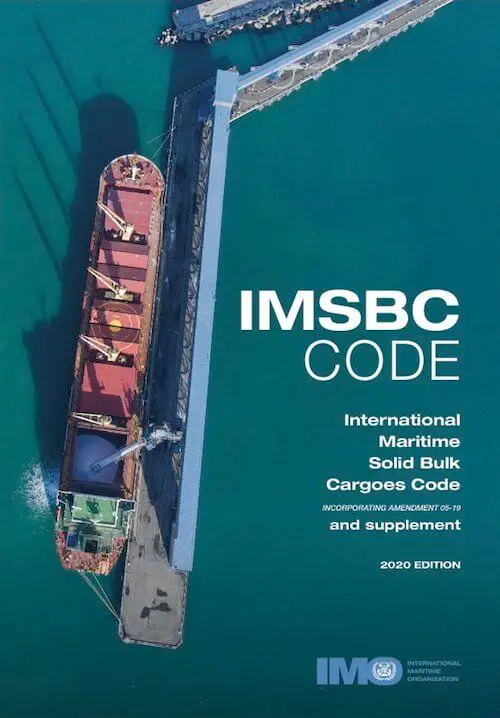
On 1 January 2009, this code was used as a voluntary, and only later in 2011 did it replace the BC CODE. The supplements also contain the blue code and the blue manual; this code contains guidelines that must be followed by the shipowner, the captain, and the person who carries out the loading and unloading operation in Bulk.
They include:
- The attention paid to some types of Bulk cargo,
- procedures regarding the loading and unloading of goods.
- This code is mainly divided into 13 sections and 4 appendices.
IMSBC Code Supplement
In addition to the Blue code and the blue manual code supplement of the IMSBC Code, it contains uniform methods for measuring the density of the Bulk cargo to understand whether it is high or low-density goods; it also contains a list of solid Bulk cargoes and recommendations on How to enter enclosed spaces and other recommendations regarding safety and the use of pesticides to fumigate cargo holds.
Blue Code
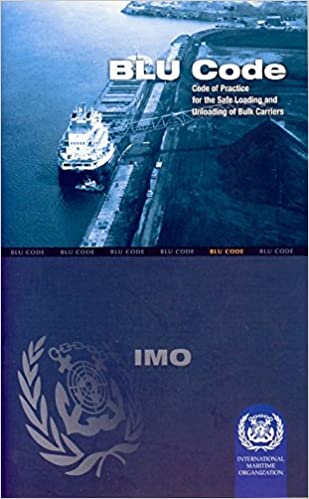
This code has the main purpose of enforcing the rules regarding the loading and unloading of the Bulk carrier.
This code was issued in November 1997 mainly for the captains of the Bulk carriers of the terminal operators or, in any case, also for the other parties involved in the unloading of dry Bulk cargoes; within this code, we find sections concerning the definitions and procedures between ship and terminal before unloading of Bulk goods.
Blu Manual
Mainly the blue manual is used by the terminal, and some sections concern what was previously described by the blue manual.
Internation Grain code
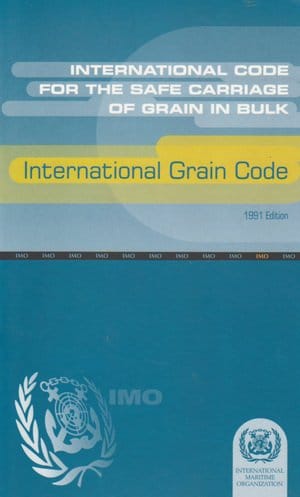
Wheat and rice seeds need particular attention when transported by bulk carriers as these can move during the transverse, negatively affecting the ship’s stability.
That is why IMO has adopted this code for which it must be carried out by all ships carrying grain or other rice cereals in Bulk.
Internation grain code is mainly divided into two parts. In the first part-specific guidelines are classified that must be followed for the correct storage of the grain, while in part B the operations that must be carried out by the officers on board the Bulk Carrer ship are described to always keep under control the inclination values of the ship
Slu code
Unless you are already an expert on Bulk carrier ships, I am sure you have never heard of Slu code.
As for the Slo code, we can define it as a code related to the correct implementation of the loading and unloading of bulk carriers.
Intact stability criteria for dry cargo ships
If you are already an officer OR in any case, a cadet officer, I am sure that you will know that during navigation, each ship must follow the rules relating to stability and fall within the criteria described by the solas lsa code and other conventions that depend on the type of ship.
In the case of ships carrying bulk cargo, there are very specific rules that this type of ship must respect; in fact, there is a chapter entirely dedicated to the stability of ships carrying bulk cargo
Bulk Carrier Trade
The Bulk carrier ship market can be defined as one of the most dynamic in the maritime world since the voyages of Bulk carrier ships are fixed according to market demand.
The bulk carrier market is very delicate, and its delicacy is closely related to the type of cargo it carries. Natural disasters such as floods or other natural disasters can compromise the exporting country’s economy.
What are the parties involved in the bulk carrier market?
The ship, the commander, the Cargo Seller, the Cargo Buyer, and charter the charter agent Maritime is a Maritime insurer. It is usually customary in Bulk carrier ships that the shipowner leases his ship and then subsequently finds sub charterer who will take care of arriving at your destination.
The journey of the Bulk carriers
before loading the bulk cargo inside the bulk carriers, a contract must be defined between the shipowner and the cargo owner, this type of contract is called affreightment; this type of contract can be either a Bill of lading carrier the owner of the vessel or charter that the owner of the cargo,
Voyage of orders
Once the shipowner or charterer has agreed with the owner of the cargo, the contract has been signed and certified by both parties; the land office will send a communication to the commander of the Bulk Carrier.
Important information that must be transcribed in the Bulk cargo transport is travel time and the cargo.
Hold preparation
Before starting a dry cargo transport journey, the ship and its crew must ensure the preparation according to the rules of the Blue code and solas and various Vincitu rules to ensure that it is necessary for the action in particular Following his instructions.
The space in the hold must be free, and there must be no trace of precious cargo
– the estimate must be dry free there must be a sign of dust paint
– it depends on the type of load to carry out the ventilation of particular types of charges also carry out the painting before loading the
Before actually loading the goods into Bulk carriers, an inspection must be carried out, and the hold inspection certificates must be issued.
Conclusion
As we have seen during this article the bulk carrier ships represent an important branch in our economy, there are different types of Bulk carrier ships each of which must meet the requirements dictated by the relevant laws and regulations, if you are going to work in Bulk carrier ships, I am sure that during your contract you will learn a lot of fundamental things thus increasing your seamanship skills.
